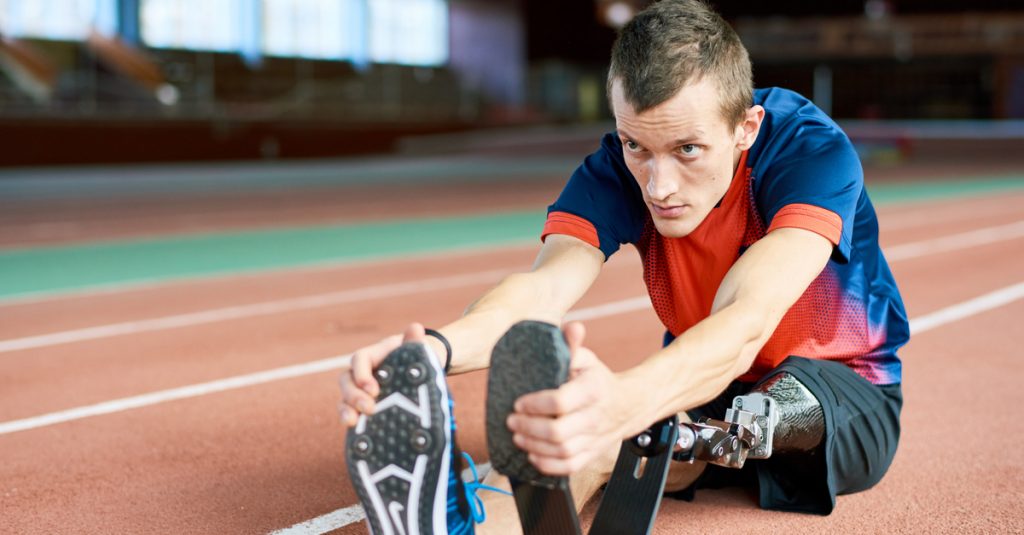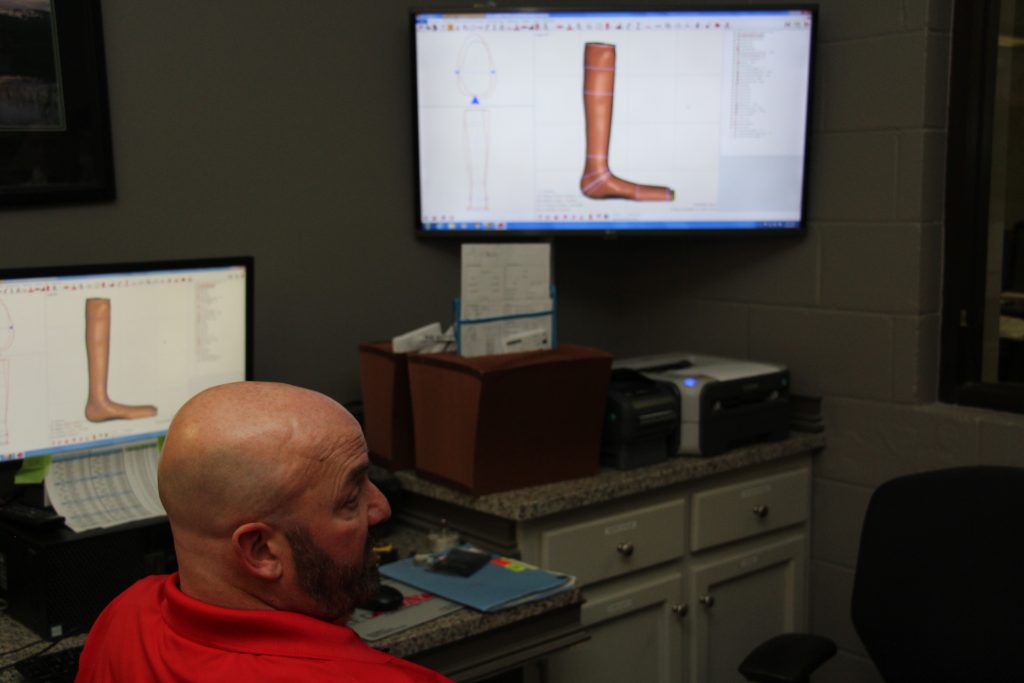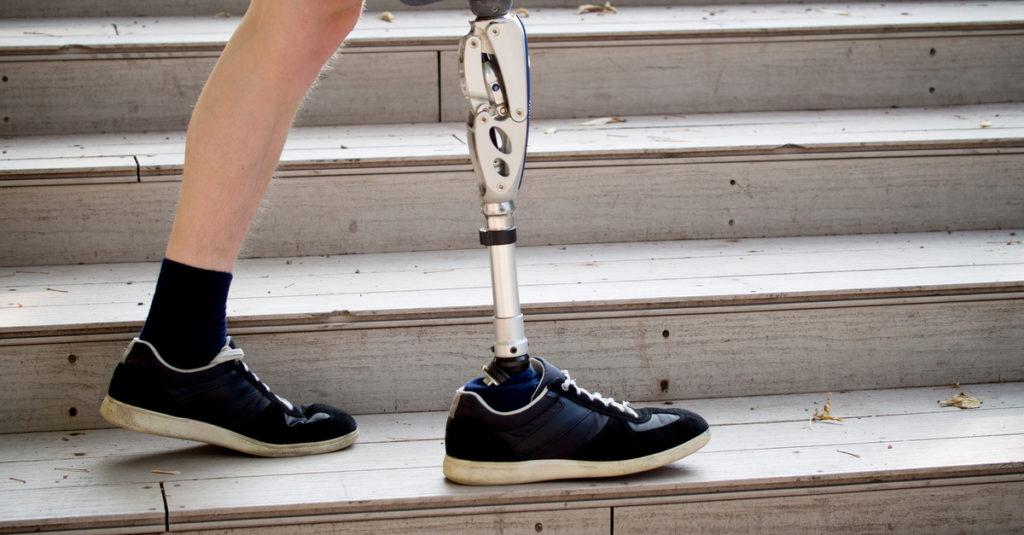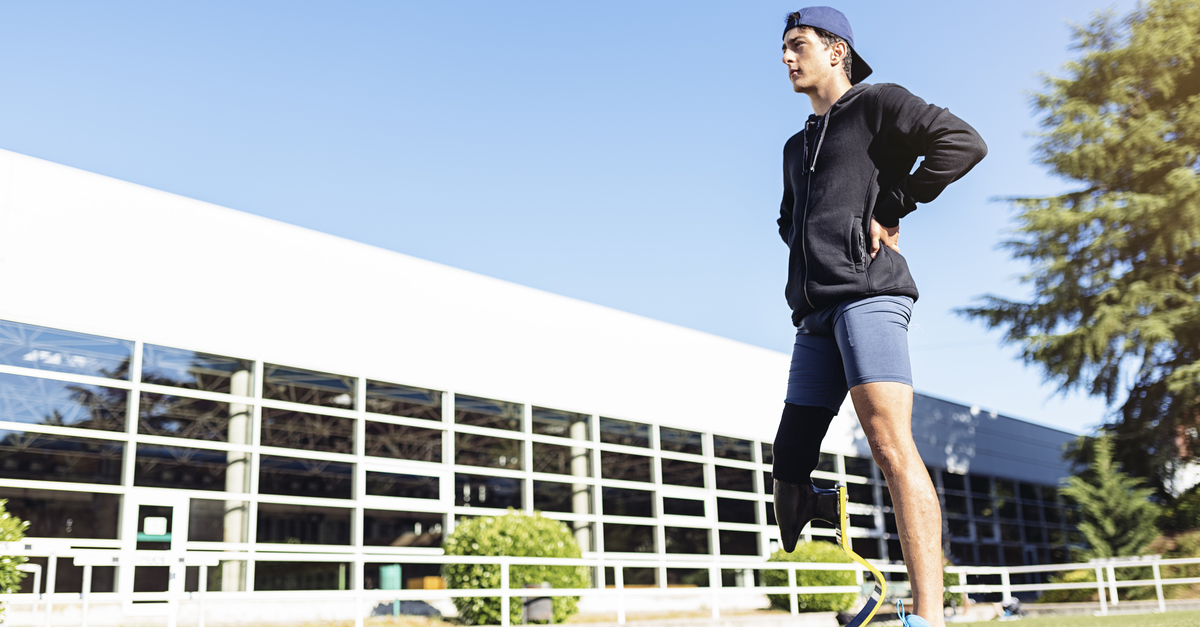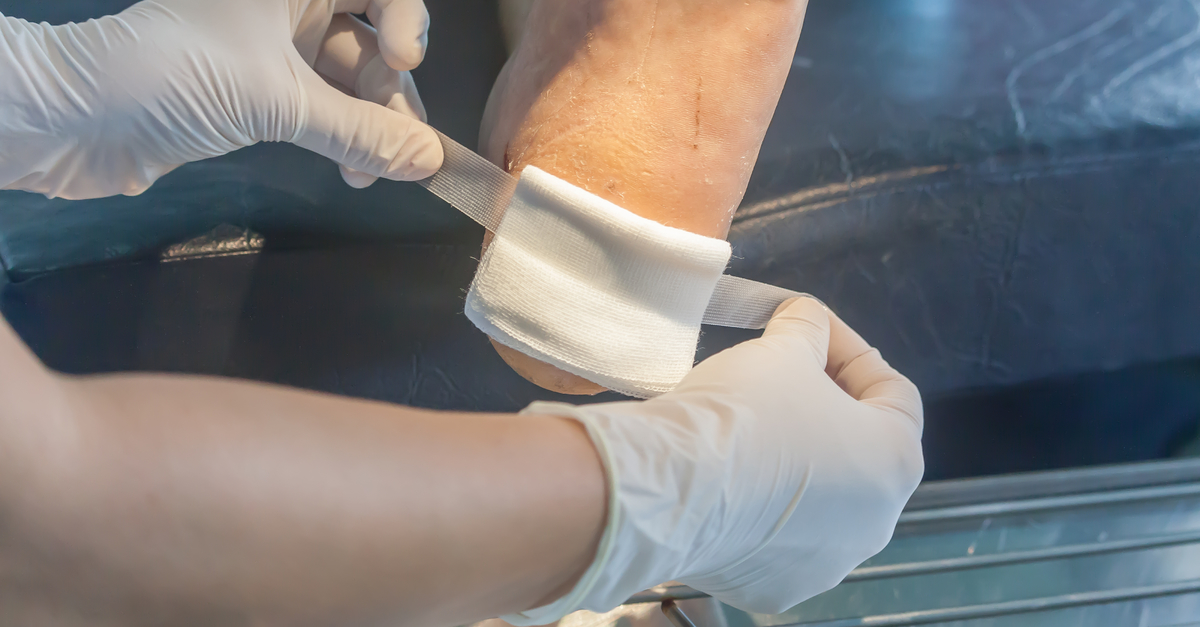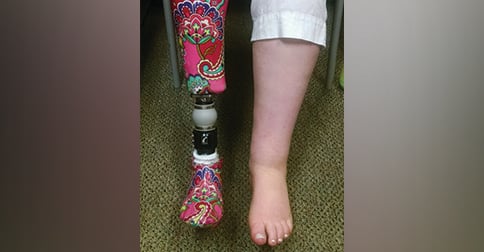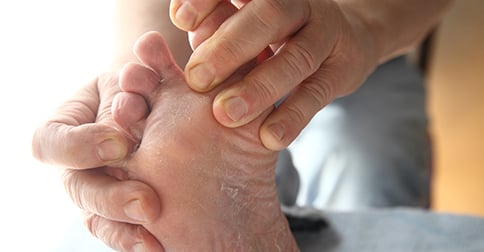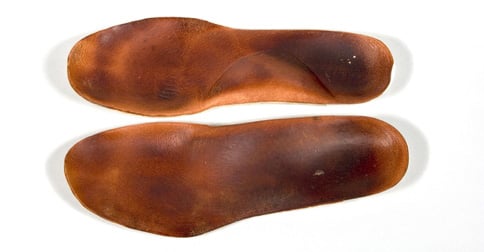One thing amputees want to do once they heal up and recover is to get back in shape - or get in shape for the first time! But they think, “Well, I can’t do this,” or, “I’ll never get back in the gym,” or, “There are certain things I just won’t be able to do.”
Of course, none of that is true! You can do it - you just have to do what everyone has to do when they want to get in shape: figure out the best way to do it.
Here’s some help with getting started.
Understand Your (Lack Of) Limitations
If you’ve just recovered from limb loss, or you have just become an amputee, you may think that there will be things you can’t do.
Fortunately, many people have gone before you and have proven that idea wrong. One of our patients, Noah Galloway, competed on Dancing With the Stars and was a part of a team that tackled the 16,024-foot Carstensz Pyramid in India.
Amputee Shaquem Griffin is a one-handed linebacker who will hear his named called during the NFL Draft and will achieve his dream of playing professional football at the highest level.
The list goes on and on. You can do anything you want, as long as you have the will to do it. Technology will help, but you must have the knowledge that you can if you want to.
Identify Your Goals and Motivations
Why do you want to get in shape?
You need a good reason. Whether you’re doing it for yourself because you want to feel better, or you’re doing it for your family because you want them to have a healthy mom or dad, the motivation behind why you’re getting in shape has to be worth doing the hard things you’ll have to do.
Understand what motivates you, then create goals around that motivation. Make these goals specific and timely. Tell yourself what you want to do and when you want to have it done. Give yourself a deadline.
Start Small and Work Your Way Up
One mistake some people make while getting back into physical activity is trying to do too much, too soon. We have a patient named James Cook who is still healing from his below-the-knee amputation. He has gotten back in the gym, but he’s taking it slow so he can let his body continue to recover and heal. He’s also learning how to move around in a gym and use proper form with a prosthetic device.
It’s okay if you have to take your time. Don’t rush it. Let your body slip back into the flow of moving around and being physical. Over time, as you adjust, you can pick up the pace and do more.
Pick Activities You Will Enjoy
This last piece of advice is perhaps the most important one. When getting into physical activity, don’t do something just because you feel obligated to, or because someone told you to, or because everyone else is doing it.
Pick a physical activity you enjoy. That will go a long way toward ensuring you stick with it and succeed.
Don’t like lifting weights? You don’t have to. You can walk, jog, or run. Or maybe you want to swim, or go hiking, or ride a bike. (And if you want to get into the gym and lift weights, you certainly can - there’s nothing that can hold you back.)
If you find something you like doing, you’ll get in better shape faster than you would if you were doing something you don’t enjoy.
The big key to getting into shape is to identify what you want and then plan how to get there. With the right motivations, goals, pace, and plan, you can take charge of your health and get into the shape you’ve always wanted - even after limb loss.
Contact the team at BioTech for more information on recognizing your possibilities!
Building a great prosthesis or orthosis is an art and a science. A lot of artistry goes into designing these devices, but we also use technology to our advantage.
Over the years, we’ve developed a proven three-step process that we use to create prosthetic and orthotic devices that fit perfectly and perform beautifully. The cutting-edge technology we use in our process is not only very effective; we also think it’s extremely cool.
Here, we’ll walk through the three components we use to build better devices for our patients.
Step #1: Laser Scanning
In the days before modern technology, we fitted patients by taking plaster casts of their limbs and then used those to carve the final product.
These days, we don’t have to do that. We have something better: laser-scanning technology.
Using a high-precision laser scanner (we have two different ways to scan your body), we can accurately capture the shape of the residual limb, or the part being braced, and upload the scan into the computer.
Lasers are far more precise and accurate than plaster or any other by-hand method. Better precision results in a better fit with the final prosthesis or brace.
Laser scans also let you show physical proof to insurance companies of why you need a new limb or brace. It gives you justification that increases the chances that insurance companies will pay for it.
Laser scanning also gives you a track record of how you have grown, which is really important when it comes to adjusting devices.
Step #2: Upload to CAD
After we take the laser scan, we upload it to our Rodin 4D computer-aided design (CAD) software.
Rodin 4D allows us to start designing the device. We can change the shape, tweak it, and make it exactly how we want.
One big advantage of using a CAD system is that you can see what the finished product will be like before you go through the production process. If there’s a problem with fit, you can notice it well before you start carving anything.
Step #3: Carving the Piece
Finally, after we’ve scanned your body and uploaded the scan into CAD to ensure the correct fit, we start the carving process.
We use a highly-specialized robot that is the first of its kind in the state of Alabama to carve solid pieces from blocks of foam. The robot is programmed using CAM software - computer-aided manufacturing - that is accurate down to millimeters. It’s amazing to watch it rotate and carve with such master precision far beyond what human hands can deliver. Since the precision is so high, the fit is guaranteed to be better than what can be done by hand.
Better Devices for Deserving Patients
Our patients deserve the best-fitting prosthetic and orthotic devices in the world. We’re confident that our three-step process using cutting-edge technology delivers those devices to our patients and gives them something that will fit and function as well as possible.
Learn more about our process by consulting with our team of specialists, and contact us to learn more about how you can get started with recognizing your possibilities.
A prosthesis, for an amputee, is something that becomes as much a part of their body as their natural limbs. That’s because you come to depend on it so much that you start to consider it a part of your real body.
That’s the goal, at least, with a well-fitting prosthesis. But what makes for a great prosthesis? What factors go into giving you the best, most comfortable, most productive fit for your body so that you can depend on your prosthesis and use it to live a full, active life?
The Fit of Your Socket
The first thing we as prosthetists try to make sure works well for you is the socket fit.
Socket fit is extremely important. When people have problems with their prostheses, it usually starts with the socket not fitting properly.
We take great care to ensure a custom socket fit through the combination of cutting-edge technology, custom materials, and decades of experience. Our goal is to mitigate the amount of friction and impact on your socket that can result in discomfort at best and pain at worst.
A properly-fitted socket will give you:
- Better control over your prosthesis’ function
- Reduced chance of friction between your limb and the socket (accomplished by fitting more snugly)
- More comfortable, healthier skin
There are a lot of factors that determine how well your socket will fit, from the material of the socket to the custom sock liner to how the prosthetic limb is suspended. Your prosthetist can go through the options with you and come up with a proper fit.
Alignment of the Prosthesis
How well all of the components of your prosthesis fit together is what we call alignment. A properly-aligned prosthesis is functional and comfortable. One that is misaligned is uncomfortable, inadequate, and unacceptable.
There are a lot of things that we consider when aligning your prosthetic device. These things include your residual limb, the size and shape of your body, your posture, the specific type of components used in your device, your control over the prosthesis, and your feedback when wearing the device.
A prosthetist takes all of the above into consideration and works with you to find the proper alignment that makes you mobile, fully functional, and comfortable. A properly-aligned prosthesis is the goal.
You!
The third factor in how well a prosthesis works is you! Specifically, we’re talking about your life, your abilities, and how well you can control the device.
We’ll look at your lifestyle - what you like to do, how active you are - plus what you do for work, your mobility, muscle strength, flexibility and coordination, stamina, balance, and more. We’re looking not just at what you can physically do now, but what you could do later.
It’s not just physical abilities, though. We also look at your mental state and how well equipped you are to handle the prosthesis and adapt to its use. This is best accomplished with physical therapy and counseling, if necessary, and we’ll work with you to help navigate this road you’re on so that you have a positive experience.
Getting the Best Prosthesis
As you can see, it’s not just about the prosthesis itself. But it’s a big part, and that’s where we come in. Our job is to make you the best prosthesis possible -- one that fits well, works well, and adapts well to your body so that it feels like an extension of yourself.
If you have any questions, or need to explore options with a prosthesis, feel free to talk to us. We’re happy to help you find the right prosthesis and the right team to support you in your journey.
For those who’ve experienced limb loss, having a prosthesis is often at the top of the list as far as things to be grateful for. But many of the innovators who made today’s prosthetic technology possible often get overlooked. Today, we would like to name just a few of these spectacular individuals and give them thanks for their selfless work.
Early History
While no one can be entirely sure when prosthetics first entered the world, there are plenty of written stories to give us a good idea. Early stories from Egypt, Greece, Rome, and beyond mention primitive prosthetics, which indicates that they were relevant at the time. One of the first great minds in surgery and prosthetic design was Ambroise Paré, whose many contributions include an above-knee contraption and a much more functional foot prosthesis. Some other notable innovators include:
- Marcel and Charles Desoutter - Creators of the first aluminum prosthesis
- Dubois Parmlee - Creator of the multi-articulated foot, polycentric knee, and suction sockets
- Pieter Verduyn - Creator of the primary non-locking below-knee prosthetic limb
While these are only a few names amongst thousands who assisted in developing the blueprint for today’s prosthesis, we are thankful for everyone who dedicated their lives to improving the wellbeing of others.
Modern History
The late 1900s brought multiple developments that would drastically improve the functionality of the prosthesis. The first major change occurred when John Sabolich C.P.O., created a new socket that allowed the user’s weight to be distributed more evenly. This game-changing invention, which eventually came to be known as the Sabolich Socket, opened up a new world of socket designs. Figures like Chris Hoyt, Frank Gottschalk, and Tim Staats added even more improvements to this new line of thought. Another great invention was the microprocessor-controlled knee, which was designed by Chas. A. Blatchford & Sons, Ltd., and allowed for quicker responses to changes of pace.
Looking Towards the Future
Recent years have been very rewarding, and the future only looks brighter for those who’ve experienced limb loss. Carbon fiber has been a huge development, which the stronger but lighter material greatly reducing the amount of energy drained from the user. Artificial limbs are also making giant leaps, with new developments happening on a weekly basis.
BioTech - Studying the Past while Changing the Future
We are proud to not only be a current leader in prosthetic technology, but an innovator and early adopter towards future developments! A great example of this is our work with carbon fiber, which has improved the lives of countless patients. We are constantly searching for the next invention that will assist our amazing clients in turning their disabilities into possibilities. Contact us today for more information.
Diabetes creates an assortment of unpleasant symptoms for the human body, but diabetic foot ulcers are by far one of the most concerning. When most people think of ulcers, they picture an irritating bump on their tongue, but foot ulcers are much more serious. Skin tissue breaks down and exposes the layers underneath, which leads to these layers being damaged.
Not only is this a serious concern, but it’s also a common one. 10% of diabetics will have to deal with this frightening symptom. Taking care of your feet is always important, but especially with diabetes. Proper foot care does so much for avoiding this life-changing problem, but even if you get foot ulcers, it’s not too late to treat them!
Treatments
More than likely, your doctor will diagnose your foot ulcer as one of these four conditions:
- (No infection) No ulcer yet, but the foot is at risk
- (Mild) Ulcer is present, but no infection
- (Moderate) Ulcer is deep in the body, affecting tendons and joints
- (Severe) Ulcers and infection are high
Depending on the diagnosis, there are a number of ways to treat foot ulcers. Various medications, equipment, and even surgery can be used to prevent this unpleasant issue from growing even more serious. Some of the more common methods are diabetic shoes, debridement (removing dead skin or anything that may have created the ulcer), antibiotics, and treating foot deformities that may be contributing to the problem.
Preparing for Limb Loss
If the ulcer continues to infect surrounding tissue, then amputation may become the best option to help preserve the rest of the leg. Another reason for amputation is critical ischaemia, which prevents the foot from properly healing. These are extreme measures that are only taken when it will improve the wellbeing of the patient.
It’s important to be prepared, both mentally and physically, before undergoing such a life-changing operation. Don’t be afraid to ask questions and prepare yourself for major changes in your daily routine. After surgery, it’s important to not only have a qualified prosthetic and orthotic team - but one that is capable and passionate about providing the best resources and support every step of the way. Have any questions about what to expect or improving your prosthetic experience? Contact BioTech today!
After limb loss, lots of the things you used to do without thinking about them may suddenly seem challenging. Traveling can be one of those things, and if your friends are making big Spring Break plans, you might be wondering how you can take part without sacrificing your safety or wellbeing. Good news – it’s totally possible to enjoy Spring Break with a prosthesis, and BioTech has all the tips!
Plan Well
Any vacation requires a certain amount of planning, but for those with limb loss, the preparation stage of the trip can be a bit more extensive. Here are a few tips for before you leave:
- Check your prosthesis for cracks, tears, loose parts, and strange sounds (these could indicate a soon-to-be-broken component).
- Pack extra supplies, such as socks, tape, socket liners, tool kit with screwdriver, and plastic bags to put over the prosthesis when you’re near sand or water.
- Take your prosthetist’s phone number and email address, just in case something happens to your prosthesis.
Address Travel Concerns
If you’re flying to your destination, make a special request for bulkhead seating. These are the seats at the front of a section, and they face a wall instead of another row of seats. Sitting here will provide you with more space, and usually, airlines reserve these seats for people with disabilities.
Wheelchair assistance is another thing to look into. Even if you can walk to your flight, a wheelchair will get you to the front of a customs line and can keep you from having to endure a strenuous journey between flights or through a large airport.
Loose clothing and shoes that slip on are essential for getting through airport security efficiently. Also, bring a letter from your doctor or prosthetist that explains your need for a prosthesis. This can be vital if a TSA agent questions anything. Expect your device to set off an alarm at security, and be proactive about giving information to agents.
If you’re not flying, consider Amtrak or Greyhound. Both are well equipped to accommodate the needs of people with disabilities, and Amtrak even offers a discount as long as you have a letter from your doctor on hand.
Gather Hotel Room Information
Before you arrive at your Spring Break destination, be sure you have called the hotel or condo in advance. Ask to speak with a person who has actually been inside the room and is familiar with its layout. Try to avoid “yes” or “no” questions.
If possible, stay on the first floor – or as close to it as you can get. Not only will this make things easier for you, but if the elevators are turned off during an emergency, you’ll be able to get out as easily as possible. And before you check in, ask to see your room to make sure they have accommodated your needs!
Spring Break with a Prosthesis Can Be Great!
There may be a few more steps to having an awesome Spring Break now that you’re an amputee, but believe us when we say that your vacation can still be everything you want it to be! Take the time to prepare, talk to your prosthetist, and make arrangements that will ensure a smooth experience. We hope you have a wonderful time!
Prosthetic devices don’t last forever, and eventually, you’ll need to replace your current prosthesis with a new one. Generally speaking, prosthetic devices are not reused in the United States due to legal issues; but it is possible to disassemble used limb prostheses and ship them to other countries for people in need.
If you’re looking for a way to donate an old prosthesis, the organizations listed below may be able to accept them, depending on their program’s current needs.
Hope to Walk
13016 Eastfield Rd. #200-310
Huntersville, NC 28078-6622
704/243-5006
hopetowalk.org
Hope to Walk designs and develops functional, affordable prosthetic devices. They also have a delivery model that allows the poorest in the world to have an opportunity to walk. They accept donations of lower-limb prostheses and/or parts.
Limbs for Life Foundation
9604 N. May Ave.
Oklahoma City, OK 73120
405/843-5174 or 888/235-5462 (toll-free)
limbsforlife.org/get-involved
The Limbs for Life Foundation collects and distributes used prostheses and prosthetic componentry, totally free of charge, to amputees in Third World countries. They use parts to create prostheses for their recipients, which reduces the costs for the prosthetist. This organization also accepts unused socks or liners.
Prosthetic Hope International
1937 Shalimar Dr.
Atlanta, GA 30345
prosthetichope.org/projects/pocc
Prosthetic Hope International’s purpose is to keep surplus usable P&O goods from being sent to landfills while so many people around the world are in desperate need of prostheses and orthoses. This organization provides a clearinghouse to individuals, P&O facilities, manufacturers, and distributors that allows them to make tax-deductible donations of new and gently used prosthetic items, and new orthotic items.
Standing With Hope
PO Box 159115
Nashville, TN 37215
866/377-7175
standingwithhope.com/prosthetics/donate-a-used-prosthetic-limb
Standing With Hope is a faith-based prosthetic outreach program that ministers to West Africa. They accept donations of socks, liners, used prostheses, and other prosthetic supplies.
Your Donation Could Change Lives!
If it’s time for a new prosthesis, your old one could change someone’s life. The list above is not an exhaustive list of donation options, so if you don’t see an organization near you, it’s worth doing some research to see if there’s one close to where you live that we haven’t listed.
Don’t forget to call BioTech for your next prosthesis fitting – we offer expedited fittings for our out-of-town patients, so your schedule can always be accommodated! Contact us today for more information.
While limb loss is incredibly difficult for adults to deal with, it can be exponentially harder for kids. Whether the child is processing the loss of his own limb or of a family member’s, he is probably dealing with high levels of shock, grief, and confusion.
Sometimes, the best way to help kids understand limb loss isn’t by telling them directly what’s going on (although open, honest conversations about the situation are vital). Stories and characters can often communicate more effectively than anyone or anything else.
Keep reading for a list of great books that can help kids understand limb loss.
#1: The Tree with No Limbs by Christine Marie Johnson
This book reminds readers that a sudden disability doesn’t make you any less real or any less you. In this story, the tree -- who has no limbs -- finds that he still has a gift inside of him, and that he can still find purpose in his life. (Though it is not listed as such, the reviews state that this is a Christian book.)
#2: Amputeddy Goes Back to School by Jean Boelter and Kate Policani
The first in a series, this story follows Amputeddy as he goes back to school after an accident that resulted in the loss of his leg. Though he worries what the other bears will think of him and whether he’ll still be able to do the things he wants to do, he ultimately learns that he can “still be a regular bear, just like everyone else.”
#3: The Making of My Special Hand: Madison’s Story by Jamee Riggio Heelan
Told from a young girl’s perspective, this story takes the reader through the process of being fitted for a hand prosthesis, which allows the narrator to do things like play with her doll and throw a ball. Though the illustrations seem to show a very young girl, the storyline is appropriate for (and could be comforting for) elementary-aged children, too.
BioTech Can Help Your Child Adjust to Limb Loss
Limb loss can be very difficult for children, but there are steps we can take to ease the transition back into normal life. We understand that children need different types of services than adults, and we are dedicated to giving them the specialized treatment and attention they deserve.
If you have a child with limb loss, please don’t hesitate to contact us for answers to your questions, solutions to your dilemmas, and the kindness of family. We are here for you!
If you have Type 2 diabetes, you may be well acquainted with the foot pain that often accompanies your condition. Or perhaps your diagnosis is recent enough that you haven’t experienced this particular symptom just yet. Either way, you must take good care of your feet, as your diabetes puts you at risk for foot ulcers, heel spurs, and even amputation.
Like many people, if it took you a while to realize your Type 2 diabetes was there, your smallest nerves and blood vessels may have suffered damage before you began treatment. The result of this is that your feet may feel numb in some places and highly sensitive in others. You may have scratches, cuts, or sores that are slow to heal. But diabetic shoes can protect your feet, and if you have Type 2 diabetes, the right shoes are essential.
Read on to learn what diabetic shoes are and why they’re so important.
How Are Diabetic Shoes Different from Regular Shoes?
Shoes that are made for people with diabetes have a toe box that is higher and wider than regular shoes. The purpose of this is to give your toes a bit more room, because if they rub against each other or against the shoe, they may blister, and they won’t heal as quickly as they did in your pre-diabetic days.
You may think you would know if your toes were blistering, but because of the numbness that comes along with nerve damage from high blood sugar, your toes cannot send your brain a distress signal when they are in pain. A roomier toe box offers extra space for your toes to spread out, shielding them from injury.
Diabetic shoes provide extra support for your arches, ankles, and heels. They also have stabilizers to keep your feet from overpronating (rolling too far inward) or underpronating (not rolling inward enough) while walking, which can cause raw spots that later become sores or blisters.
And finally, diabetic shoes are usually deeper than regular shoes so that you can use an orthotic insert. These inserts can correct an irregular stride, give your heel more cushioning, and offer your arch more support. Many people with Type 2 diabetes use inserts, so the extra depth is vital.
Things to Consider When Shoe Shopping
When you go shopping for a pair of diabetic shoes, make sure they don’t have any inner seams that might irritate your foot and cause a sore or blister. Feel the inside of the shoe to make sure the inner lining is smooth and even.
Slip-ons may be tempting because of the convenience factor, but ultimately, they’re not a good idea. Your feet will swell during the course of the day, and because slip-ons can’t be adjusted, you may have chafing issues in the morning and loss of circulation in the evening. Look for shoes with Velcro or laces instead -- that way, you can adjust them so that they fit properly, no matter the time of day.
Make sure that your shoes have removable insoles. You may need to replace them with prescription or over-the-counter orthotic inserts, so the ability to take out the original insoles is a must.
The time of day that you go shopping is important, too. As mentioned above, your feet tend to swell in the afternoon and evening, so that’s the best time to try on shoes. Even if you plan to buy online because of the lower prices, trying on shoes in person is the best way to make sure you end up with a comfortable, functional pair.
Need Diabetic Shoes? Call BioTech!
Here at BioTech, we offer a wide range of custom orthotics -- including diabetic shoes and custom-molded diabetic inlays. We take your comfort and health seriously, and we won’t rest until you have a great pair of shoes that provide you with an excellent quality of life. Contact us today!
If you’ve always thought of foot orthotics as a modern invention, think again! Let’s take a look at the captivating story of foot orthotics, from awkward beginnings to modern-day technology.
Historical Predecessors
The first known orthotic foot devices date back almost 2,000 years! Layers of wool were inserted into sandals to relieve foot strain and fatigue, giving the wearer -- who almost certainly spent most of the day on his or her feet -- a bit of extra cushioning.
The first recorded use of arch support occurred in 1865, when Everett H. Dunbar of Bridgewater, Massachusetts, inserted leather “lifts” between the insole and the outsole of his shoe, giving extra support to the arch.
The First True Foot Orthotics
The Whitman Brace, which debuted in 1905, is considered the first true foot orthotic and was introduced to the world by Boston orthopedist Royal Whitman. The device, a stiff metal arch support flanged around the heel and the arch, was popular among orthopedic surgeons because of Whitman’s reputation in the field -- even though it was bulky, heavy, and distorted the wearer’s shoe.
In 1910, Dr. William Scholl (yes, that Dr. Scholl) came out with a much lighter, more flexible metal support called the Foot-Easer. As you may have guessed, millions of pairs sold over the next several years.
Orthotics in the Footwear Industry
The 1920s and 30s brought a wave of “corrective” shoe production. These shoes promised to prevent, correct, or relieve a wide variety of foot issues. Over time, these corrective shoes became a major part of the footwear industry -- and a very lucrative one, too.
The demand for corrective shoes was so high that at one point, there were nearly 1,000 different brands on the market, including 200 “doctor” shoes. The advertising campaigns for these shoes became so outrageous that, in the late 1940s, the Federal Trade Commission was forced to issue cease-and-desist orders. In the wake of this discouragement, the corrective shoe business faded away.
Modern Foot Orthotics
Twenty years later, orthotics gained new traction as materials became lighter, more flexible, and stronger. By the 1970s, when jogging became trendy and athletic footwear was on the upswing, foot orthotics developed even more rapidly. Athletes reported more and more foot and lower limb injuries, and the orthotics industry responded.
Soon, athletic shoes came with orthotic features such as flared heels, contoured sole inserts, and underfoot cushioning. Doctors began specializing in sports medicine, which included orthotics as a standard part of treatment. Today’s orthotics look nothing like the crude Whitman Brace -- a fact that orthotic wearers everywhere have reason to celebrate.
Looking for Foot Orthotics? Call BioTech!
At BioTech, we can help you with everything from custom molded shoes to diabetic inlays. Of course, foot orthotics is just the tip of the iceberg when it comes to the services we offer! Contact us today for all of your prosthetic and orthotic device needs. We are here to serve you!
